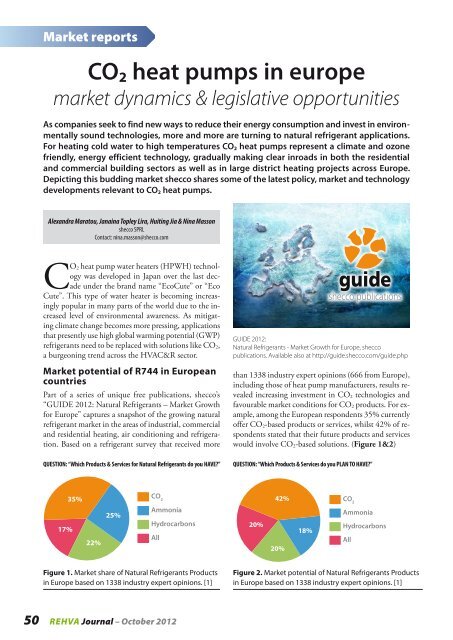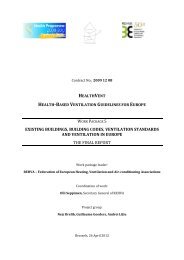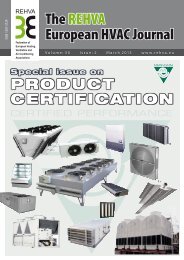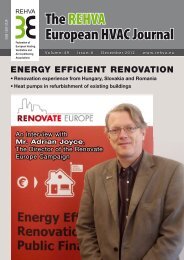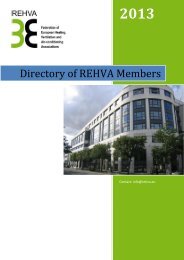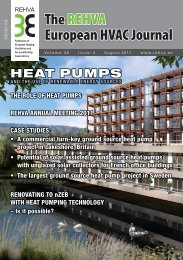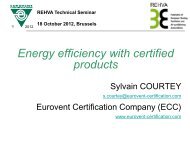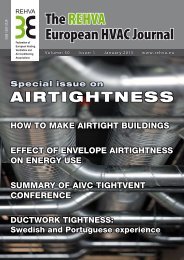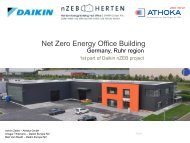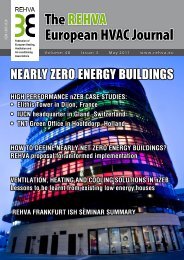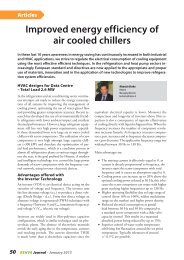CO2 Heat Pumps in Europe Market Dynamics & Legislative ... - shecco
CO2 Heat Pumps in Europe Market Dynamics & Legislative ... - shecco
CO2 Heat Pumps in Europe Market Dynamics & Legislative ... - shecco
Create successful ePaper yourself
Turn your PDF publications into a flip-book with our unique Google optimized e-Paper software.
<strong>Market</strong> reports<br />
CO 2 heat pumps <strong>in</strong> europe<br />
market dynamics & legislative opportunities<br />
As companies seek to f<strong>in</strong>d new ways to reduce their energy consumption and <strong>in</strong>vest <strong>in</strong> environmentally<br />
sound technologies, more and more are turn<strong>in</strong>g to natural refrigerant applications.<br />
For heat<strong>in</strong>g cold water to high temperatures CO 2 heat pumps represent a climate and ozone<br />
friendly, energy efficient technology, gradually mak<strong>in</strong>g clear <strong>in</strong>roads <strong>in</strong> both the residential<br />
and commercial build<strong>in</strong>g sectors as well as <strong>in</strong> large district heat<strong>in</strong>g projects across <strong>Europe</strong>.<br />
Depict<strong>in</strong>g this budd<strong>in</strong>g market <strong>shecco</strong> shares some of the latest policy, market and technology<br />
developments relevant to CO 2 heat pumps.<br />
Alexandra Maratou, Jana<strong>in</strong>a Topley Lira, Huit<strong>in</strong>g Jia & N<strong>in</strong>a Masson<br />
<strong>shecco</strong> SPRL<br />
Contact: n<strong>in</strong>a.masson@<strong>shecco</strong>.com<br />
CO 2 heat pump water heaters (HPWH) technology<br />
was developed <strong>in</strong> Japan over the last decade<br />
under the brand name “EcoCute” or “Eco<br />
Cute”. This type of water heater is becom<strong>in</strong>g <strong>in</strong>creas<strong>in</strong>gly<br />
popular <strong>in</strong> many parts of the world due to the <strong>in</strong>creased<br />
level of environmental awareness. As mitigat<strong>in</strong>g<br />
climate change becomes more press<strong>in</strong>g, applications<br />
that presently use high global warm<strong>in</strong>g potential (GWP)<br />
refrigerants need to be replaced with solutions like CO 2 ,<br />
a burgeon<strong>in</strong>g trend across the HVAC&R sector.<br />
<strong>Market</strong> potential of R744 <strong>in</strong> <strong>Europe</strong>an<br />
countries<br />
Part of a series of unique free publications, <strong>shecco</strong>’s<br />
“GUIDE 2012: Natural Refrigerants – <strong>Market</strong> Growth<br />
for <strong>Europe</strong>” captures a snapshot of the grow<strong>in</strong>g natural<br />
refrigerant market <strong>in</strong> the areas of <strong>in</strong>dustrial, commercial<br />
and residential heat<strong>in</strong>g, air condition<strong>in</strong>g and refrigeration.<br />
Based on a refrigerant survey that received more<br />
QUESTION: “Which Products & Services for Natural Refrigerants do you HAVE?”<br />
guide<br />
<strong>shecco</strong> publications<br />
Get <strong>in</strong> touch with us to learn how we can help you <strong>in</strong> gather<strong>in</strong>g bus<strong>in</strong>ess<br />
<strong>in</strong>telligence, gett<strong>in</strong>g your climate technology faster to market and<br />
spread the message among decision makers.<br />
GUIDE 2012:<br />
Natural Refrigerants - <strong>Market</strong> eMail Growth us at for <strong>Europe</strong>, <strong>shecco</strong><br />
research@<strong>shecco</strong>.com<br />
publications. Available also at http://guide.<strong>shecco</strong>.com/guide.php<br />
talk to us oN the phoNe<br />
(+32) 2 230 3700<br />
than 1338 <strong>in</strong>dustry expert op<strong>in</strong>ions (666 from <strong>Europe</strong>),<br />
<strong>in</strong>clud<strong>in</strong>g those of heat pump our MailiNG manufacturers, address results revealed<br />
<strong>in</strong>creas<strong>in</strong>g <strong>in</strong>vestment Rue Royale <strong>in</strong> 15 CO 2 technologies and<br />
<strong>shecco</strong> house<br />
1000, Brussels<br />
favourable market conditions<br />
Belgium<br />
for CO 2 products. For example,<br />
among the <strong>Europe</strong>an respondents 35% currently<br />
offer CO 2 -based products or services, whilst 42% of respondents<br />
stated that their future products and services<br />
would <strong>in</strong>volve CO 2 -based solutions. (Figure 1&2)<br />
QUESTION: “Which Products & Services do you PLAN TO HAVE?”<br />
17%<br />
35%<br />
22%<br />
25%<br />
CO 2<br />
Ammonia<br />
Hydrocarbons<br />
All<br />
20%<br />
42%<br />
20%<br />
18%<br />
CO 2<br />
Ammonia<br />
Hydrocarbons<br />
All<br />
Figure 1. <strong>Market</strong> share of Natural Refrigerants Products<br />
<strong>in</strong> <strong>Europe</strong> based on 1338 <strong>in</strong>dustry expert op<strong>in</strong>ions. [1]<br />
Figure 2. <strong>Market</strong> potential of Natural Refrigerants Products<br />
<strong>in</strong> <strong>Europe</strong> based on 1338 <strong>in</strong>dustry expert op<strong>in</strong>ions. [1]<br />
50<br />
REHVA Journal – October 2012
<strong>Market</strong> reports<br />
With regard to market policy conditions 63% of participants<br />
believe the bus<strong>in</strong>ess and policy climate for<br />
CO 2 <strong>in</strong> <strong>Europe</strong> to already be “rather” or “very” positive.<br />
(Figure 3)<br />
QUESTION:<br />
“How is the Bus<strong>in</strong>ess and Policy Climate evolv<strong>in</strong>g <strong>in</strong><br />
your country (location of organisation)?”<br />
Ammonia<br />
46%<br />
50%<br />
33%<br />
Hydrocarbons 45%<br />
41% 40%<br />
40% CO 2<br />
37%<br />
34%<br />
NR overall<br />
30%<br />
29%<br />
5%<br />
14%<br />
20%<br />
17%<br />
18%<br />
2%<br />
11%<br />
10%<br />
9%<br />
5%<br />
3% 4% 3%<br />
4%<br />
0%<br />
Highly<br />
Negative<br />
Rather<br />
Negative<br />
Not<br />
Mov<strong>in</strong>g<br />
<strong>in</strong> Any<br />
Direction<br />
Rather<br />
Positive<br />
Benefits of CO 2 heat pump water<br />
heaters (HPWH)<br />
Highly<br />
Positive<br />
Figure 3. <strong>Market</strong> and Policy Environment of Natural<br />
Refrigerants <strong>in</strong> <strong>Europe</strong>. Responses of 1338 <strong>in</strong>dustry<br />
experts. [1]<br />
HPWHs are a relatively mature technology and have<br />
ga<strong>in</strong>ed popularity over the past decade with<strong>in</strong> the water<br />
heat<strong>in</strong>g <strong>in</strong>dustry because of their ability to deliver significantly<br />
more heat for the same amount of electricity<br />
compared to traditional electric storage water heaters<br />
(SWH).<br />
The CO 2 heat pump water heater cycle is transcritical,<br />
operat<strong>in</strong>g at much higher temperatures and pressures<br />
than conventional subcritical cycles. The transcritical<br />
cycle operation provides a large cont<strong>in</strong>uous temperature<br />
glide and can offer a higher service temperature with<br />
limited capacity loss.<br />
CO 2 heat pumps <strong>in</strong>stallations <strong>in</strong><br />
commercial applications <strong>in</strong> <strong>Europe</strong><br />
Today most of the CO 2 heat pumps are designed for<br />
Domestic Water <strong>Heat</strong><strong>in</strong>g (DWH), with Japanese companies<br />
like Panasonic, Daik<strong>in</strong>, DENSO, Sanden, Itomic<br />
and Mitsubishi some of the most active promoters of the<br />
technology. Whilst the Japanese market can be considered<br />
mature, CO 2 heat pumps represent a niche market<br />
<strong>in</strong> <strong>Europe</strong>. However, more and more Japanese companies<br />
are enter<strong>in</strong>g the <strong>Europe</strong>an market, redesign<strong>in</strong>g their<br />
CO 2 heat pumps to fit the <strong>Europe</strong>an way of life, climate,<br />
hous<strong>in</strong>g structures as well as EU and national energy and<br />
safety standards.<br />
Local CO 2 heat pump manufacturers are also emerg<strong>in</strong>g,<br />
with companies like Stiebel, enEX, ICS, Thermea,<br />
Kylma, CTC, JCA, and Viessmann add<strong>in</strong>g CO 2 heat<br />
pumps to their product ranges.<br />
Outside the domestic market, commercial real estate<br />
owners are beg<strong>in</strong>n<strong>in</strong>g to see CO 2 heat pumps as a promis<strong>in</strong>g,<br />
high performance option for high temperature<br />
sanitary hot water for hotels, restaurants, hospitals,<br />
schools and other public build<strong>in</strong>gs. Evidence of this can<br />
be seen <strong>in</strong> some most recent examples of commercial applications<br />
of CO 2 heat pumps <strong>in</strong> <strong>Europe</strong>:<br />
Denmark: A large scale 100% renewable energy project<br />
that provides the Danish city of Marstal with a largescale<br />
district heat<strong>in</strong>g system <strong>in</strong>corporates a 1.5 MW<br />
thermally CO 2 driven heat pump. The project, developed<br />
with a grant from the EU’s Seventh Framework<br />
Programme (FP7), <strong>in</strong>cludes a solar plant, a comb<strong>in</strong>ed<br />
heat and power (CHP) system, an Organic Rank<strong>in</strong>e<br />
Cycle (ORC) Unit and a 75 000 m³ pit for heat storage,<br />
with the CO 2 heat pump mov<strong>in</strong>g energy to the energy<br />
storage pit.<br />
Ireland: Ecocute Innovation and Design Limited<br />
(Ecocute Ltd) has <strong>in</strong>stalled an air to water transcritical<br />
CO 2 heat pump (TCHP) water heat<strong>in</strong>g system to supplement<br />
the O’Donovan’s Hotel’s exist<strong>in</strong>g solar thermal<br />
system. The Hotel’s domestic hot water is now supplied<br />
by a 25 kW transcritical CO 2 heat pump that can<br />
operate at a seasonal performance factor of 3.2 when<br />
generat<strong>in</strong>g hot water at 75°C <strong>in</strong> Irish ambient conditions<br />
of 9.4°C air temperature and 10°C water <strong>in</strong>let<br />
temperature.<br />
Also <strong>in</strong> Ireland, the Cúil Díd<strong>in</strong> Residential and Nurs<strong>in</strong>g<br />
Care Facility <strong>in</strong> Tralee county Kerry has <strong>in</strong>stalled a transcritical<br />
CO 2 heat pump to supply hot water for the<br />
laundry facilities, kitchens and for the care of the residents.<br />
The new CO 2 heat pump can produce 2 500 litres<br />
of hot water per night at 90°C, which is able to meet<br />
the hot water demand 24 hours a day. Overall, cost sav<strong>in</strong>gs<br />
of 70‐80% are expected.<br />
France: A McDonald’s <strong>in</strong> France <strong>in</strong>stalled a CO 2 heat<br />
pump produced by Panasonic to comply with the energy<br />
and emission reduction priorities for new and exist<strong>in</strong>g<br />
build<strong>in</strong>gs <strong>in</strong> the French government’s Grenelle<br />
REHVA Journal – October 2012 51
<strong>Market</strong> reports<br />
Environment project (Grenelle de l’environnement).<br />
The CO 2 heat pump is able to reach a high pressure of<br />
130 bars (most other heat pumps that can only reach 15<br />
bars) provid<strong>in</strong>g comfort cool<strong>in</strong>g.<br />
Switzerland: In 2011, thermea. Energiesysteme <strong>in</strong>stalled<br />
a high-temperature heat pump thermeco2 at the campus<br />
of the University of Applied Sciences South Westphalia.<br />
The heat pump uses low-temperature waste heat from<br />
the ventilation and refrigeration plant and supplies the<br />
university canteen with hot water and heat<strong>in</strong>g. With<br />
a total heat<strong>in</strong>g capacity of 45 kW, the thermeco2 heat<br />
pump reaches high performance values (COP) even<br />
with a temperature lift of about 65°C. The COP values<br />
of 3.0 and 3.5 measured by the manufacturer surpassed<br />
values predicted by thermea.<br />
Build<strong>in</strong>g regulations <strong>in</strong> EU Member<br />
States underp<strong>in</strong> trend towards<br />
sanitary hot water heat pumps<br />
The year 2011 saw a trend towards sanitary hot water<br />
heat pumps - an application most suitable for R744: accord<strong>in</strong>g<br />
to latest statistics by the <strong>Europe</strong>an <strong>Heat</strong> Pump<br />
Association sales of sanitary hot water heat pumps have<br />
close to doubled <strong>in</strong> 2011 compared to 2010 levels reach<strong>in</strong>g<br />
about 48 000 units.<br />
This trend is underp<strong>in</strong>ned by new build<strong>in</strong>g codes and<br />
regulations adopted <strong>in</strong> different EU Member States, regulations<br />
that typically place a ceil<strong>in</strong>g on primary energy<br />
consumption of build<strong>in</strong>gs or require the <strong>in</strong>tegration<br />
of renewable energy. Sanitary hot water heat pumps<br />
provide a straightforward means to <strong>in</strong>tegrate renewable<br />
energy sources (RES) and reduce primary energy consumption<br />
<strong>in</strong> build<strong>in</strong>gs.<br />
For example the amendment of the Energy Sav<strong>in</strong>g<br />
Ord<strong>in</strong>ance (“Energiee<strong>in</strong>sparverordnung - EnEV”) that<br />
regulates energy performance for new and exist<strong>in</strong>g<br />
build<strong>in</strong>gs <strong>in</strong> Germany is underway and is expected to<br />
raise current requirements further. The Ord<strong>in</strong>ance sets<br />
requirements regard<strong>in</strong>g primary energy demand, tak<strong>in</strong>g<br />
<strong>in</strong>to account both <strong>in</strong>sulation of the build<strong>in</strong>g envelope<br />
and the energy efficiency of equipment used for heat<strong>in</strong>g,<br />
sanitary hot water etc.<br />
The Jo<strong>in</strong>t Research Centre estimates that by 2020 heat<strong>in</strong>g<br />
and cool<strong>in</strong>g will represent the highest sectoral share<br />
<strong>in</strong> the gross f<strong>in</strong>al energy consumption, of 48% (http://<br />
ec.europa.eu/dgs/jrc/downloads/jrc_reference_report_<br />
2011_reap.pdf). With<strong>in</strong> this context and as the EU<br />
moves towards low or zero energy build<strong>in</strong>gs that encompass<br />
m<strong>in</strong>imal space heat<strong>in</strong>g requirements, sanitary<br />
hot water and energy efficient technologies for its provision<br />
are set to become all the more important.<br />
Conclusion<br />
Grow<strong>in</strong>g environmental awareness coupled with more<br />
str<strong>in</strong>gent <strong>Europe</strong>an build<strong>in</strong>g codes and regulations have<br />
provided a strong boost to environmentally friendly<br />
heat<strong>in</strong>g and cool<strong>in</strong>g solutions. S<strong>in</strong>ce the revival of CO 2<br />
as a refrigerant, started almost 20 years ago <strong>in</strong> <strong>Europe</strong>,<br />
there has been a strong development of new technology,<br />
with CO 2 now widely recognised an attractive and competitive<br />
alternative refrigerant to the synthetic fluids <strong>in</strong><br />
heat pump applications.<br />
Reference:<br />
[1] GUIDE 2012: Natural Refrigerants - <strong>Market</strong> Growth for<br />
<strong>Europe</strong>, <strong>shecco</strong> publications. Available also at<br />
http://guide.<strong>shecco</strong>.com/guide.php<br />
This is the case <strong>in</strong> France for example where the 2012<br />
Thermal Regulation (Réglementation Thermique 2012<br />
- RT2012) was launched at the end of 2010, replac<strong>in</strong>g<br />
2005 Thermal Regulations (RT2005). In general, all<br />
new build<strong>in</strong>g constructions must achieve average primary<br />
energy consumption of less than 50 kWh/m²/year for<br />
heat<strong>in</strong>g, domestic hot water, cool<strong>in</strong>g, light<strong>in</strong>g and auxiliary<br />
equipment (e.g. fans and pumps) compared to the<br />
average of 150 kWh/m²/year required by RT2005.<br />
This trend is expected to cont<strong>in</strong>ue <strong>in</strong> the long term as<br />
more and more national governments <strong>in</strong> the EU are<br />
expected to adopt build<strong>in</strong>g codes and regulations that<br />
encompass similar requirements and accommodate the<br />
requirements of the recast EU Energy Performance of<br />
Build<strong>in</strong>gs Directive agreed back <strong>in</strong> 2010.<br />
<strong>shecco</strong> is a market<strong>in</strong>g & communications expert help<strong>in</strong>g<br />
companies worldwide br<strong>in</strong>g their climate friendly solutions<br />
faster to market. We focus on the transport and HVAC&R sectors,<br />
where <strong>in</strong> the latter we developed special expertise on natural<br />
refrigerants, <strong>in</strong>clud<strong>in</strong>g ammonia,<br />
CO 2, hydrocarbons, water and<br />
air. <strong>shecco</strong>’s services range from<br />
world-lead<strong>in</strong>g <strong>in</strong>dustry platforms,<br />
to <strong>in</strong>ternational workshops, market<br />
guide<br />
<strong>shecco</strong> publications<br />
Get <strong>in</strong> touch with us to learn how we can help you <strong>in</strong> gather<strong>in</strong>g bus<strong>in</strong>ess<br />
<strong>in</strong>telligence, gett<strong>in</strong>g your climate technology faster to market and<br />
spread the message among decision makers.<br />
research and consultancy services,<br />
publications, <strong>in</strong>ternational projects,<br />
and public affairs.<br />
52<br />
REHVA Journal – October 2012<br />
eMail us at<br />
research@<strong>shecco</strong>.com<br />
talk to us oN the phoNe<br />
(+32) 2 230 3700


